|
Their stories are different but share a common thread: They played far from the bright lights of the big-time college football programs, but didn't give up their dream of playing in the NFL. The road to the NFL away from the Power 5 spotlight and through the Football Championship Subdivision or even Division II presents its own set of obstacles, from lesser facilities and amenities to the challenge of catching the eye of pro scouts. But several players have navigated that route and are hoping to hear their name called during the 2022 NFL draft on April 28-30 on ESPN and ABC. Some, such as Cole Strange, Christian Watson and Pierre Strong Jr., wowed observers at the NFL combine. Others, including Joshua Williams, Noah Elliss and Cordell Volson, had skills that could not be ignored. And Elliss and Watson have NFL experience in their blood. Our team of college football reporters -- Chris Low, Heather Dinich, Bill Connelly, Harry Lyles Jr. and Kyle Bonagura -- share the stories of some small school draft prospects who, through hard work, determination and resolve, are bucking the odds in taking an unconventional path to the draft.
Cole Strange, Chattanooga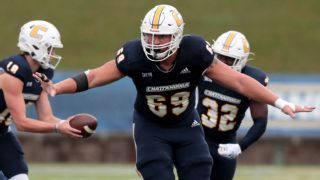 Cole Strange's introduction to playing on the offensive line was a No. 69 jersey and a pair of knee braces sitting in front of his locker when he arrived at the University of Tennessee at Chattanooga back in 2016. The closest he had come to playing on the offensive line to that point was taking a few snaps at tight end in high school. As a 245-pound defensive end/linebacker coming out of Farragut High School in Knoxville, Tennessee, Strange flew under the radar during the recruiting process. He jokes now that even as a lifelong Tennessee Volunteers fan who never missed a home game as a kid, the only way he could get on campus as a recruit was to tag along with a high school teammate. "And that was an unofficial visit because he got to bring some guests," Strange said. "Here I was in the Tennessee weight room, and I thought it was the coolest thing in the world. But I never got a sniff from them, not even as a preferred walk-on." In fact, Strange said the only FBS schools to offer him a scholarship were Air Force and Army. He was all set to go to Air Force before deciding that Colorado was farther away from home than he wanted to be as a 17-year-old. Strange is no longer flying under the radar as he prepares for the NFL draft on the heels of an impressive showing at the Senior Bowl and a remarkable display of athleticism during workouts at the combine. The 6-foot-5, 307-pound Strange has also showcased his versatility, as he worked at center during Senior Bowl week after playing left guard for most of his college career. "I felt all along that I could play with anybody," said Strange, a five-year starter at Chattanooga and first-team FCS All-American as a senior. "There wasn't really a moment that it clicked for me at the Senior Bowl or anything like that. I knew it was an opportunity for me to prove myself -- not prove it to myself, but prove to the scouts and teams who were watching me go against guys who played at bigger schools. "So it wasn't really, 'Can I do this?' It was more, 'OK, I need to come in here and dominate.'" Chattanooga coach Rusty Wright predicted that Strange would put up monster workout numbers at the combine, which is exactly what happened. Strange's broad jump of 120 inches was an inch off the combine record for an offensive lineman. He also did 31 reps on the bench press, vaulting his overall workout numbers to the very top of this year's class of interior offensive linemen. Strange is currently No. 4 on ESPN draft analyst Todd McShay's list of guard prospects, and the fact that Strange has shown he can also play center should only help him continue to climb draft boards. His performance at the combine could elevate him to a Day 2 pick and potentially the highest drafted player from any school in the state of Tennessee. Not bad for a guy who became accustomed to long bus rides for road games in college and learned to cook for himself, along with his younger brother, Dylan, while living off campus his last two years. "We always fixed plenty," said Strange, who was primarily focused on gaining weight earlier in his career. "We ate decently too. It wasn't like we were eating pizza, chicken wings and beer every night." While there might have been a time when Strange felt spurned by some of the college football powerhouses, he never felt the urge to leave Chattanooga for a chance to play in the SEC, ACC or anywhere else. In other words, the lure of the transfer portal was never really a lure in his eyes. Strange made that clear last summer when he walked into Wright's office and told him, "I made a commitment to y'all, and that's not going to change." That's not the only commitment Strange has made to Chattanooga. He started out in the nursing program before realizing that some of his classes and shift rotations would interfere with football practice. He switched to psychology and earned his undergraduate degree in 2020; he is now halfway to his master's degree in engineering management. "I'd like to finish that," Strange said. Given the way he finishes blocks and just about everything else, nobody's betting against him. "He's one of those guys that doesn't just try to block you. He tries to hurt you," Wright said. "He's not stopping until he's blocking guys underneath the bleachers." -- Chris Low
Noah Elliss, Idaho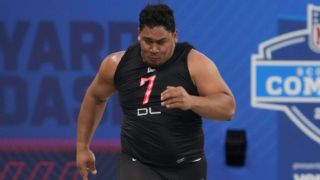 Former Idaho defensive tackle Noah Elliss is poised to follow his father's footsteps to the NFL, and he's nearing his lifelong dream despite having played only 11 collegiate games. Total. His dad and former position coach, Luther Elliss, described it as a "flash in the pan of a college career" that included overcoming a torn ACL and MCL in 2019. Add in a COVID-canceled 2020 season that resulted in a six-game 2021 spring season. All in the FCS. Bring on the NFL draft. "If you can play, they'll find you," said Luther Elliss, who spent nine seasons with the Detroit Lions and five seasons as an assistant coach at Idaho. "It shows we have talented kids, but it also shows you how difficult it is to get into the league because here we are, we're a smaller, lower-level FCS program, still putting out a couple of kids who have opportunities every year. "And yet there's other kids at Alabama, Georgia, that aren't even getting looked at -- three, four stars. It's just to say the NFL doesn't care where the talent comes from. The NFL cares that you're talented and you have the DNA or the makeup to sustain and do well in the league." Elliss, who had originally committed to Mississippi State, had more than 20 scholarship offers, including from the likes of Alabama, Auburn, Ole Miss, Oklahoma and Notre Dame. Relationships, though, outweighed the brand names, and when former defensive line coach Brian Baker left Mississippi State for Alabama, Elliss chose to join his dad at Idaho. Two of his brothers also played for the Vandals, and Kaden Elliss was taken by the New Orleans Saints in the seventh round of the 2019 draft. "I've always had the aspirations to play at the next level," said Elliss, one of 12 children in the family, including eight his parents adopted. "I remember watching my dad play, and I remember him coming out of the tunnel and that made me at that moment want to be like him and get there. It's always been a dream of mine and something I've always wanted." While at Idaho, Elliss had to overcome significant knee injuries with outside help, as the school's rehabilitation services were mostly shuttered because of the pandemic. "[They said] here's what you need to do, and he just kind of had to do it on his own," Luther Elliss said. "That really shows a lot about his character, his resolve, his grit." Elliss said he consulted an online program based in California to help strengthen his knee, and while most FBS teams have a full-time nutritionist, Elliss said most of the dietary monitoring during that time was on him. "I kind of had to almost keep track of what I was eating to keep myself in shape every day," he said. "The facility wasn't as great, but that didn't really matter to me at all. Just being able to play football was the only thing that mattered to me." It still is. The 6-foot-4, 359-pound Elliss was invited to the NFL combine and spent about two months in Arizona training for it. His size isn't a problem -- by comparison, Georgia's Jordan Davis is listed at 6-6, 340. The difference is the competition they've faced. Luther Elliss said a competitive edge can often help compensate for what some players in the FCS might lack in physical evaluations. "The eye test might not always pass here at this level," Luther Elliss said, "but the heart and the passion to play this game is just as much equal or maybe even better because they know they don't have all of those measurables." -- Heather Dinich
Christian Watson and Cordell Volson, North Dakota State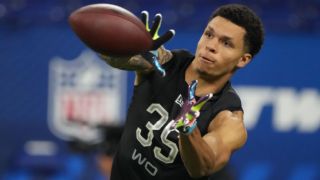 Virtually any North Dakota State draft prospect, especially on offense, has to be viewed through a very specific lens. The Bison are an FCS dynasty, winners of nine of the past 11 national titles and purveyors of a unique brand of precise and physical play. They maul FCS defensive fronts and run the ball at will, and that colors the impression we get when a draft prospect bubbles to the surface. (From first-round quarterbacks Trey Lance and Carson Wentz to linemen such as 2021 second-rounder Dillon Radunz and Billy Turner, a starter for the Green Bay Packers now with the Denver Broncos, plenty of prospects have done just that of late.) It especially colors the impressions of a deep-threat receiver such as Christian Watson. The Bison star tested extraordinarily well at the NFL combine, measuring 6-4, 208 pounds with a 4.36 time in the 40. His physical traits are thrilling, and he has NFL in his blood: His father, Tim, spent five seasons in the league, while brother Tre had a cup of coffee with the Miami Dolphins. Watson was, like so many FCS stars, a late bloomer. Listed at just 5-9 as a high school sophomore, he saw recruiting attention go primarily to more physically impressive teammates -- including former Indiana star Whop Philyor -- at Plant High School in Tampa, Florida. But thanks to a late growth spurt, he got NDSU's attention. Once in Fargo, he blossomed. Watson quickly became both too big and too fast for anyone trying to guard him at the FCS level, and his stats bear this out: Over parts of four seasons in Fargo, he caught 105 passes for 2,140 yards and 14 touchdowns and rushed a Deebo Samuel-esque 49 times for 392 yards and two more scores. That's an average of 20.4 yards per catch and 8.0 yards per carry; throw in a 26.4-yard kick return average, and you've got a player who was plainly too explosive for college football's second subdivision. "To be at my size and do the things that I do," he told The Draft Network, "being able to combine that with my catch radius and the things that I'm able to utilize ... I'll be able to make plays that other receivers can't." Of course, because of these physical advantages, Watson probably hasn't been tested much when it comes to things like route precision and his ability to catch contested balls. Opponents had to commit to stopping the run -- NDSU would just keep hammering teams with the ground game until they did so -- which meant Watson was generally left to beat overmatched cornerbacks and distracted safeties. His upside is immense, as are his effort levels, with ESPN's Jordan Reid projecting him to be picked near the top of the second round in his latest mock draft and Todd McShay having him going toward the end of the first round. 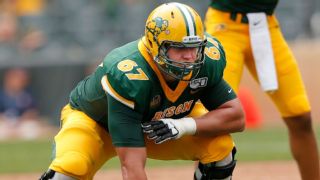 For Cordell Volson, a spectacular Bison lineman, it's a similar story. He measured 6-6 and 315 pounds, and despite his length, he was an absolute mauler in the run game. From Anamoose, North Dakota, Volson is, like Watson, an almost prototypical late-bloomer story. He was listed at 242 pounds in high school and chose to follow his brother Tanner to NDSU over offers from Wyoming and in-state rival North Dakota, where he could have starred opposite another 2022 draft prospect, tackle Matt Waletzko. (A star center, Tanner won the FCS' Rimington Award in 2018 and spent time on the New York Giants' scout team.) Volson redshirted for one season, then served as a backup for two, piling on both pounds and technique in the process. He started in 2019 and the 2021 spring season, and took advantage of the extra year of eligibility allotted to all 2020-21 athletes by starring again as a super senior this past fall. Volson played on both the right and left sides and logged time at both tackle and guard. He can get low and run over defenders. NDSU's offensive line -- "the Rams," as they call themselves -- was even more devastating than usual in 2021, and he's an obvious reason why. As with Watson, what we know about Volson is almost universally positive. But he also brings a predictable unknown to the table when it comes to pass blocking. He didn't really have to do a ton of it at North Dakota State, and while there is an abundance of solid, speedy pass-rushers at the FCS level, there aren't many high-quality power rushers. "[He] changes direction and has good body control and wants to come off the ball and be the most violent person in the nation," NDSU offensive coordinator Tyler Roehl told North Dakota's Inforum after Volson's NFL combine performance. "He fits. You see him walking around with the other offensive linemen, he fits." -- Bill Connelly
Pierre Strong Jr., South Dakota StatePierre Strong Jr., a native of Little Rock, Arkansas, didn't have any in-state scholarship offers coming out of high school despite a prolific career, which led him to believe that if he couldn't get an offer in-state, he certainly wouldn't get one out of state. However, South Dakota State's running backs coach at the time, John Johnson, had heard of Strong because he also is from Arkansas. "Once he heard about me, he reached out to me ... so that's just how it happened," Strong said. In his final season at South Dakota State, Strong rushed for 1,686 yards and 18 touchdowns while averaging 7.0 yards per carry. He views himself as a three-down back with great hands who can run with power or take it the distance -- a "home-run hitter," as he describes it -- comparing himself to Alvin Kamara. Strong said he felt that his NFL dreams came within reach once the Jackrabbits played Colorado State last season. In that game, he had 138 yards rushing on 13 carries with two touchdowns in three quarters of football. From that point, he said scouts started taking him more seriously. "It was a game that I was just thinking like, 'Yeah, this is that game that put me on,'" he said. From that game forward, Strong ran his way to an invitation to the NFL combine. He knew that once his opportunity came, he needed to stand out with his performance because of where he was coming from. "I would tell [my trainers], 'Man, I'm from a smaller school, a 4.4 is not good enough,'" Strong said. "A lot of people run 4.4s, you know? Not too many people who are running backs run 4.3s, so I've got to make myself stand out even more. So once I got to that 40-yard dash, I just knew what time it was." Strong had the NFL combine he knew he needed, with his 4.37 time in the 40-yard dash standing out as the best among his position group. "I just knew I had to do something to separate myself from the others that were already on the map," he said. "I just had to do something." Because of his 40-yard dash time, Strong went from being just another good FCS prospect to being considered among the best at the combine. He is among Mel Kiper Jr.'s top five running backs. Strong said he thinks building his career up from a smaller program has helped fuel the work ethic that pushed him to this point, with the beginning of his NFL career on the horizon. "I know that I have to work a little extra just to get to where I want to go," he said. "I always use the saying that 'I took the stairs, I ain't take the elevator.' ... It's just a chip on my back mentality." -- Harry Lyles Jr.
Joshua Williams, Fayetteville State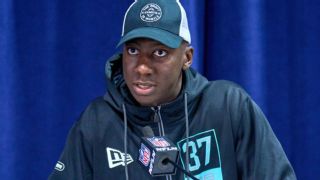 In an age when online recruiting profiles often detail how future NFL or NBA players were underhyped coming out of high school, there is a common storyline. "[Insert player] was only a two-star prospect. Look at these schools that were interested in him." That is followed by a list of a few schools, who are then credited for their superior evaluations. Unlike the lightly recruited stories above, cornerback Joshua Williams never even had a profile created, his high school career was so obscure. After a year at prep school and three seasons at Division II Fayetteville State, a historically Black university that competes in the Central Intercollegiate Athletic Association, Williams left eligibility on the table and entered the NFL draft. At 6-3, 195 pounds, Williams possesses a rare combination of size and agility, even by NFL standards. "The first thing with him is that he has feet like a corner who is 5-10 and he has hips that are just like that," said Fayetteville State assistant head coach James Lott, a four-year starter for Clemson from 1985-89. "I knew when I first saw him that if there was anything he wanted to do, he could. He just needed someone to take him from A to Z." Lott had recruited Williams out of prep school when he was on staff at Johnson C. Smith University, but didn't get the chance to start coaching him until he was hired at Fayetteville late last spring. Williams saw his entire 2020 season wiped out due to COVID, so while he kept working out, there was ground to be made up from a technical standpoint. Even so, the word was out last summer among NFL scouts that Williams was someone worth checking in on. The steady stream of scouts who came through campus marveled at Williams' fluidity and size. When the season began, he immediately made up for the lost time, returning an interception 32 yards for a touchdown in the season opener. A dominant season followed, setting him up with options. He generated interest from larger schools that could have provided a greater platform to test his skills, but Williams decided he didn't need that. In November, he snagged the lone invitation the Senior Bowl issued to a Division II player, and there he matched up favorably with some of the best prospects in the draft. "I think there was a lot of good that came out of the Senior Bowl in his mind and my mind," Lott said. "I think he understood that, 'Hey, I'm from Fayetteville State University, but I'm here with all these other guys and I'm competitive.'" Of the 38 cornerbacks at the NFL combine, Williams' NFL Next Gen stats evaluation score ranked him No. 12. "Believe it or not, you ask anybody I grew up with, I was always saying I was going to end up here," Williams said at the combine. "It hasn't been easy, but I always truly did believe that I'd get here." He just needed a chance. -- Kyle Bonagura
|
